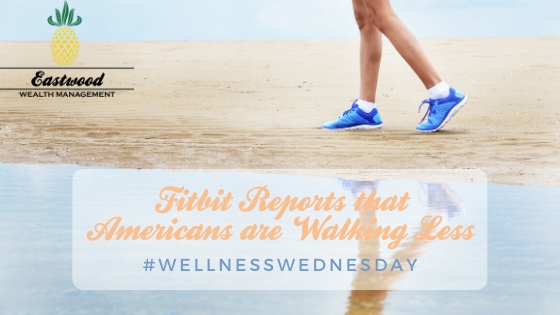June 24, 2020

Tips to feeling more empowered regarding your financial
needs and goals
The makers of the fitness tracking device Fitbit reported that Americans were less active during the spread of coronavirus, as we stayed-at-home and practiced social distancing.
In the U.S., walking “steps” by individual Fitbit users were down an average of 12% during the fourth week of March, compared to the same period a year ago. And in cities across our country, the decline was even more pronounced as steps were down:
- 14% in Seattle;
- 18% in Boston;
- 20% in San Francisco; and
- 20% in New York.
Outside the U.S., the decline was even more severe, with steps down 38% in Spain and 25% in Italy.
The data was particularly alarming since Fitbit users tend to be more affluent and more active than the general public, so statisticians think the decline in physical activity during COVID-19 has been even more pronounced.
But rather than lament the fact that our step-count has declined during COVID, let’s instead take that lost time and use it to get into healthy financial shape.
Building a Healthy Financial Life
Much like getting in shape, losing weight or working out more, living a healthy financial life is easier said than done. If you’re like many people, finances may overwhelm you. How do you replace the fear with a roadmap and resources to start you building your plan?
The two biggest barriers to getting financially fit: finding the time and knowing how and where to start. Demands of career and family leave little time to learn how to manage finances.
It Just Takes One Day
Set aside a day soon to learn more about your personal financial situation. In that short time, you can learn enough to tremendously affect your financial life.
Your schedule could be:
A cup of coffee and a computer. Start with a healthy breakfast because your brain operates better on good fuel. That’s indisputable.
Next, take a couple of hours to read about finance. The goal isn’t to become a financial expert in a few hours but to learn more about what you do and don’t know about your own financial situation. Read about economics, the markets or company earnings. Just read – it will help better understand your money.
Then take a break and digest what you learned. Maybe go for a walk and erase that 12% Fitbit deficit.
After lunch, take a few minutes to make a list of what you learned and your remaining questions. Include issues you believe you still need to address, such as saving for college or reviewing insurance. This list provides the basis for setting your goals.
Calculate Your Net Worth
Devote a few hours to two important details: tracking your spending and knowing how much you are worth. Do you really know where all your money goes? Everyday expenses or habits – like spending $100 every time you eat out – are stealth budget busters that quickly add up.
Track and record your expenses for the past six months to a year. When you see exactly where your money goes – shopping, eating out or just too many indulgences – you see right away where to cut spending or re-prioritize to save more.
Next, create a net-worth statement to look at what you own – and owe, even if you think you know your financial picture. Your statement simply lists all your assets such as bank, brokerage and retirement accounts, as well as the value of your home, car and other possessions. It also lists your liabilities: your outstanding credit card balances, home mortgage and car or student loans, to name a few.
The difference between the two lists constitutes your net worth, and knowing it is the key to establishing personal financial goals and the baseline for measuring progress as you work to meet your goals.
Talk to Your Financial Professional
Most people who take a day like this feel more empowered regarding their financial needs and goals. Knowing where you stand helps you know what to do next, rather than worry about loose financial ends.
Once you’ve taken this day for yourself, set a meeting with your financial professional so that you can confirm what you’ve learned and together you can either create or refine your financial plan.
Important Disclosures
The opinions voiced in this material are for general information only and are not intended to provide specific advice or recommendations for any individual.
The information provided is not intended to be a substitute for specific individualized tax planning or legal advice. We suggest that you consult with a qualified tax or legal advisor.
All information is believed to be from reliable sources; however LPL Financial makes no representation as to its completeness or accuracy.
This article was prepared by RSW Publishing.
LPL Tracking 01-05013569
VIEW OUR Business Continuity Plan
CFP® Certified Financial Planner™ Certified Financial Planner Board of Standards, Inc. owns the certification marks above, which it awards to individuals who successfully complete initial and ongoing certification requirements.
Securities and advisory services offered through LPL Financial, a Registered Investment Advisor Member FINRA + SIPC.
The LPL Financial registered representative associated with this site may only discuss and/or transact securities business with residents of the Following states: NC, VA, SC, MD, DE and FL.
Financial planning services offered through LPL Financial, a registered investment advisor